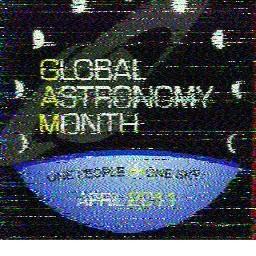GAM News
- Created: Tuesday, April 05 2011 07:58
How the GAM logo made a trip to the Moon and back 
To the right is the GAM 2011 logo looking a bit worn. It should - this image has has been to the Moon and back. After being sent by radio to the Moon and reflected off the Moon's surface, the weakened signal was retrieved on its return to Earth after its nearly half-million, 2.5 second trip at the speed of light.
Below is the story of how this GAM logo made it's incredible journey.
Pat Barthelow, a radio enthusiast in the US who is very involved in Moonbounce, thought sending the GAM logo to the Moon and back would be a great way to promote both GAM and Moonbounce. Pat sent a copy of the GAM logo to Jan Van Muijlwijk at the large radio telescope in Dwingeloo, the Netherlands, and to Daniela de Paulis, an artist working with Jan on an art and science project, Opticks. Dwingeloo is one of the many radio dishes around the world that are active in Moonbounce activities but it's also one of the largest. Though radio communications reflected from the Moon and received back on Earth were first done in the 1940s, Dwingeloo is where sending and retrieving images began. Daniela suggested to Jan that they try adding images to ongoing Moonbounce communications using a shareware program called MMSSTV, and Imagebounce was born.
Jan, Daniela and Pat work with a worldwide team of radio amateurs doing Moonbounce projects. Howard Ling, a Moonbouncer with a 5.4-meter diameter Moonbounce radio dish at his home in Gainsborough, England, transmitted the GAM logo to the Moon as Dwingeloo stood by. After reflecting off the Moon's surface, Dwingeloo picked up the return signal 2.5 seconds later, the time it takes for radio waves to go to the Moon and back at the speed of light. The signal strength was far weaker than when it left Earth, having been diminished by it's almost half-million mile journey and scattering on the lunar surface. Dwingeloo's large size made it possible to receive the weak signal with sufficient data left to reconstruct the image. The slightly degraded return image almost looks like it picked up some of that lunar surface in the process, and that image noise is now referred to by some as "moon dust" (a humorous reference, NOT the real thing). The resulting image, reconstructed after its cosmic journey, is a truly unique activity involving photography, art, technology and plenty of fun.
Daniela de Paulis along with Jan Van Muijlwijk and the Dwingeloo team will be Moonbouncing images on April 10, at 16:00 UTC in a special activity that can be viewed live on UStream. This presentation will also promote Yuri's Night, a worldwide event that also takes place during GAM and will have several Moonbounce activities of its own.
Lunar Week follows from 10 to 16 April with many programs focused on our closest neighbor in space as takes its place in the early evening sky.
See the Program Schedule for all the GAM Global Programs.







